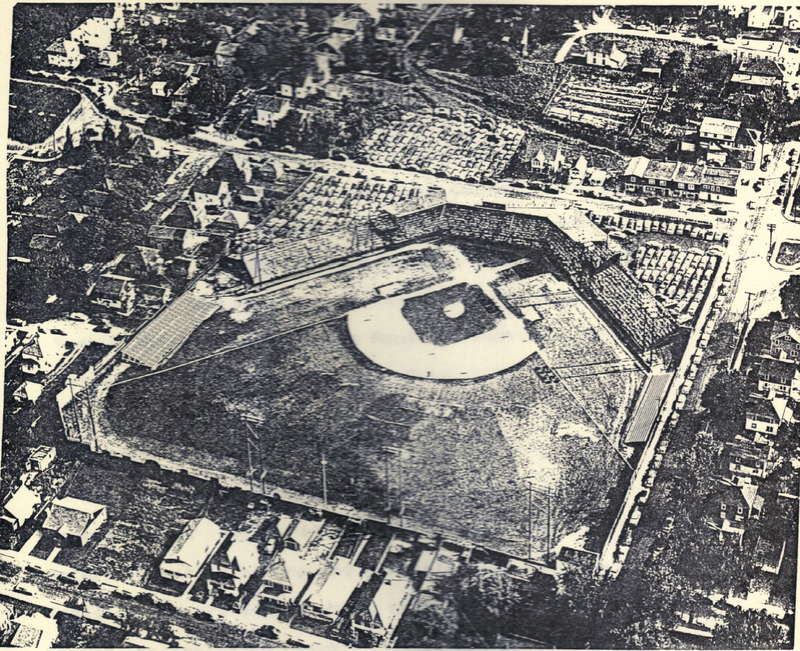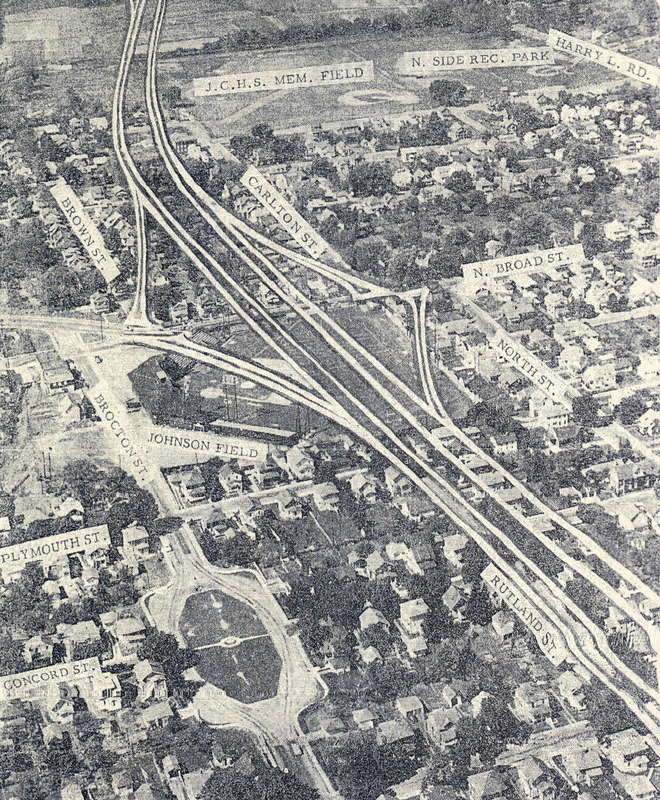EJ, Television, and Johnson Field: The Destruction of the Binghamton Triplets
By David Fixler
Johnson Field the former home of the Binghamton Bingos, Broomes and Triplets was built in 1913 with the financial backing of George F. Johnson, the Endicott-Johnson president at the time. It lasted for 55 years but was demolished in 1968 when Route 17 was built right through the ballpark. Throughout those 55 years, Johnson Field saw boxing matches, football games and especially baseball games. The field was home to some of the greatest entertainment that Binghamton had to offer for 55 years but when New York State decided to build Route 17 through Johnson Field, there was no replacement. The goal of my research was to figure out why baseball left Binghamton when Johnson Field was destroyed.
In 1913, George F. Johnson built Johnson Field. At the time Johnson Field was one of the most modern fields in the country and was a considered to be a great recreational facility for the Binghamton area. Although in the beginning it was updated to the highest standards over time the field deteriorated and was not adequately improved. When Johnson Field was created there were approximately 2,000 seats available. This was increased to 5,500 seats by the 1930s and was never updated again. The lack of seating became an issue when famous Yankee players came for exhibition games against the Triplets. With tens of thousands of fans at these games seating became an issue. On a related note, as you can see from the picture to your left, the parking for Johnson Field was also severely limited.
In the 1950s and 60s, the poor conditions at the field were quite apparent. According to a former Binghamton employee “As to the visiting team’s dressing room, it would be condemned by any State Housing Commission survey team.” It had always been difficult to keep the fields dry in the springtime, but the inadequateness of the rest of the field really exemplified this.
Another fact about Johnson Field that limited its future was the dimensions of the field. The left and right field dimensions were so much farther away then center field, which is drastically different from most ballparks and especially Yankee Stadium which was the future for most Binghamton Triplets. Mickey Mantle played a half a season for the Triplets in 1951 but didn't come back the next year because of the conditions at the ballpark.
Without adequate facilities, there became less and less of a reason to try and keep the field from being destroyed.
In 1951, the State of New York announced plans to have Route 17 go through Johnson City and Johnson Field. Although there were repeated attempts to try and convince the State legislator to go through a different area the proposition failed and Johnson Field was scheduled to be destroyed. Many members of the Johnson Field community did not want the destruction of the field to be the end of the Binghamton Triplets as well. One of the more prominent members of the community that didn't believe in a future ballpark for the Triplets was the Endicott-Johnson president, Frank A. Johnson. He said, "It is our intention that the ballpark in Johnson City will be preserved with or without a baseball team". Although his feelings on the matter may not have been popular the economy of Binghamton supported his statement. At this time Endicott-Johnson had started outsourcing jobs and gone into a general decline along with the rest of the Binghamton area with deindustrialization. Although the community wanted a new ballpark, facilities are expensive.
The Binghamton Press created this outline to represent a possible future for the Triplets. Ultimately it was all for naught as the field was destroyed along with the Binghamton Triplets.
From 1945 to 1948 attendance at minor league baseball games increased from 10.7 to 40.9 million. But by 1951, attendance at minor league games had decreased to 27.5 million. As you can see there is a significant decline in attendance at minor league baseball games through a short time period. One of the most significant sources of this decline is the increase in television sets in the American home. 1947 was the first year that the world series was on TV and between 1949 and 1969, the number of households in the U.S. with at least one TV set increased drastically from less than a million to 44 million. Americans were watching more TV, therefore, they didn't need to have as much interest in following their local minor league team.
Another possible reason for the significant decline in minor league baseball during the 1950s and 1960s was the increase in strength and widespread use of radio during this time. Binghamton weather during the springtime has never been great and so it quite obvious to see how residents would prefer to listen to games rather than sit in the cold, wet weather. People were able to follow Major League Baseball teams easier and therefore grew less interested in their local teams.
A widespread reason for the decline can possibly be attributed to the overexpansion of minor league baseball teams into cities that didn't have the population to support them.
Bibliography
Maples, Linda. 1989. Johnson Field: A History. State University of New York at Binghamton
Meisel, Barry. “This broker’s game was baseball.” Sun-Bulletin, March 14, 1980
Only Litter Roams Outfield” Binghamton Press, September 13, 1968
Surdam, David G. 2005. "Television and Minor League Baseball: Changing Patterns of Leisure in Postwar America." Journal of Sports Economics 61-77.
“Three Champions Meet at Johnson Field” Binghamton Press, September 6, 1938
U.S. House of Representatives. (1952). Organized baseball: Hearings before the Subcommittee on Study of Monopoly Power of the Committee on the Judiciary, House of Representatives. Serial No. 1, Part 6, 82nd Congress, 1st Session. Washington, DC: U.S. Government Printing Office.



